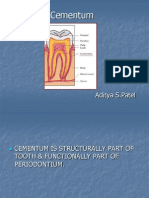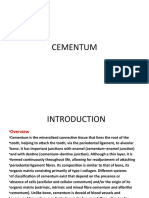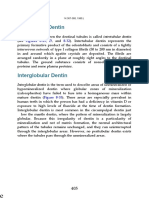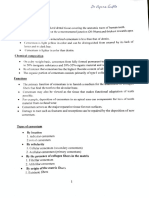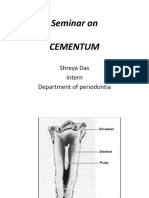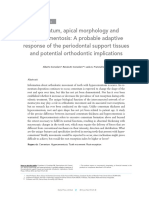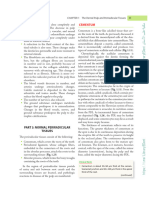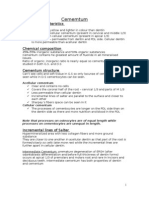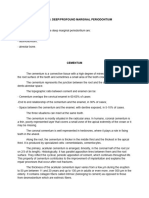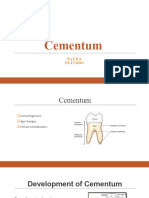Cementum PDF
Cementum PDF
Uploaded by
Hafra AminiCopyright:
Available Formats
Cementum PDF
Cementum PDF
Uploaded by
Hafra AminiOriginal Title
Copyright
Available Formats
Share this document
Did you find this document useful?
Is this content inappropriate?
Copyright:
Available Formats
Cementum PDF
Cementum PDF
Uploaded by
Hafra AminiCopyright:
Available Formats
11 Cementum
Cementum is the thin layer of calcified tissue covering the
dentine of the root (Fig. 11.1). It is one of the four tissues that
support the tooth in the jaw (the periodontium), the others
being the alveolar bone, the periodontal ligament and the
gingivae. Although many of these periodontal tissues have
been extensively studied, cementum remains the least known.
Indeed, it is the least known of all the mineralised tissues in
the body. For example, very little is known about the origin,
differentiation and cell dynamics of the cementum-forming
cell (the cementoblast).
Although restricted to the root in humans, cementum is
present on the crowns of some mammals as an adaptation to
a herbivorous diet. Cementum varies in thickness at different
levels of the root. It is thickest at the root apex and in the interradicular areas of multirooted teeth, and thinnest cervically.
The thickness cervically is 1015 m, and apically 50200 m
(although it may exceed 600 m).
Cementum is contiguous with the periodontal ligament
on its outer surface and is firmly adherent to dentine on
its deep surface. Its prime function is to give attachment
to collagen fibres of the periodontal ligament. It therefore is a
A
C
Fig. 11.2 The relationship between cementum (B), precementum
(arrow), a layer of cementoblasts (A), and the periodontal ligament
(C) (Decalcified section; H & E; 200).
highly responsive mineralised tissue, maintaining the integrity
of the root, helping to maintain the tooth in its functional
position in the mouth, and being involved in tooth repair and
regeneration.
Cementum is slowly formed throughout life and this
allows for continual reattachment of the periodontal ligament fibres some regard cementum as a calcified component
of the ligament. Developmentally, cementum is said to be
derived from the investing layer of the dental follicle. Like
dentine, there is always a thin layer (35 m) of uncalcified
matrix on the surface of the cellular variety of cementum (see
page 346). This layer of uncalcified matrix is called precementum (Fig. 11.2). Similar in chemical composition and
physical properties to bone, cementum is, however, avascular
and has no innervation. It is also less readily resorbed, a feature
that is important for permitting orthodontic tooth movement.
The reason for this feature is unknown but it may be related
to:
Fig. 11.1 The distribution of cementum (A) along the root of a
tooth (Ground longitudinal section of a tooth; 4).
168
differences in physicochemical or biological properties
between bone and cementum;
the properties of the precementum;
the increased density of Sharpeys fibres (particularly in
acellular cementum);
the proximity of epithelial cell rests to the root surface.
The arrangement of tissues at the cementenamel junction
is shown in Figs 11.311.5. In any single section of a tooth,
three arrangements of the junction between cementum and
enamel may be seen. Pattern 1, where the cementum overlaps
the enamel for a short distance, is the predominant arrangement in 60% of sections. Pattern 2, where the cementum and
enamel meet at a butt joint, occurs in 30% of sections. Pattern 3,
where the cementum and enamel fail to meet and the dentine
between them is exposed, occurs in 10% of sections. Although
CEMENTUM
one of these patterns may predominate in any individual
tooth, all three patterns can be present.
E
D
PHYSICAL PROPERTIES
Cementum is pale yellow with a dull surface. It is softer than
dentine. Permeability varies with age and the type of cementum,
the cellular variety being more permeable. In general, cementum
is more permeable than dentine. Like the other dental tissues,
permeability decreases with age. The relative softness of
cementum, combined with its thinness cervically, means that
it is readily removed by abrasion when gingival recession exposes
the root surface to the oral environment. Loss of cementum in
such cases will expose dentine.
E
D
169
CHEMICAL PROPERTIES
Fig. 11.3 Three patterns for the arrangement of the
cementenamel junction. C = Cementum; E = enamel; D = dentine.
See text for further details.
Fig. 11.4 Scanning electron micrograph of the cementenamel
junction where the cementum overlaps the enamel. A = Cementum;
B = enamel (SEM; 250).
Cementum contains on a wet-weight basis 65% inorganic
material, 23% organic material and 12% water. By volume,
the inorganic material comprises approximately 45%, organic
material 33%, and water 22%. The degree of mineralisation
varies in different parts of the tissue; some acellular zones may
be more highly calcified than dentine. The principal inorganic
component is hydroxyapatite, although other forms of calcium
are present at higher levels than in enamel and dentine. The
hydroxyapatite crystals are thin and plate-like and similar to
those in bone. They are on average 55 nm wide and 8 nm
thick. Their length varies, but values derived from sections cut
with a diamond knife are underestimates due to shattering of
the crystals along their length. As with enamel, the concentration of trace elements tends to be higher at the external
surface. This, for example, is true of fluoride levels, which are
also higher in acellular than in cellular cementum. The
organic matrix is primarily collagen. The collagen is virtually
all type I. In addition, the non-collagenous elements are assumed
to be similar to those found in bone (see page 206). However,
because of the difficulties of obtaining sufficient material for
analysis, less information is available. Nevertheless, among
the important molecules known to be present are bone
sialoprotein, osteopontin and possibly other cementumspecific elements that are conjectured to be involved in
periodontal reattachment and/or remineralisation.
CLASSIFICATION OF CEMENTUM
The various types of cementum encountered may be classified
in three different ways: the presence or absence of cells, the
nature and origin of the organic matrix and a combination of
both.
C
Fig. 11.5 Ground longitudinal section through a tooth to show
cementum (A) overlapping enamel (B). C = Dentine (Ground section;
80). Courtesy of Professor A.G.S. Lumsden.
Classification based on the presence or absence of
cells cellular and acellular cementum
Cellular cementum, as its name indicates, contains cells
(cementocytes); acellular cementum does not. In the most
common arrangement, acellular cementum covers the root
adjacent to the dentine, whereas cellular cementum is found
mainly in the apical area and overlying the acellular
cementum (Fig. 11.6). Deviations from this arrangement are
170
ORAL ANATOMY, HISTOLOGY AND EMBRYOLOGY
B
A
Fig. 11.6 The distribution of acellular (A) and cellular
(B) cementum.
common and sometimes several layers of each variant alternate. Being formed first, the acellular cementum is sometimes
termed primary cementum and the subsequently formed
cellular variety secondary cementum. Cellular cementum is
especially common in interradicular areas.
Acellular cementum appears relatively structureless (Fig.
11.7). In the outer region of the radicular dentine, the
granular layer (of Tomes) can be seen and outside this the
hyaline layer (of Hopewell-Smith). These layers are also
described on page 136. A dark line may be discerned between
the hyaline layer and the acellular cementum; this may be
related to the afibrillar cementum that is patchily present at
this position. The usual arrangement at the apical region of
the root is of a layer of cellular cementum overlying acellular
cementum (Fig. 11.8). Many of the structural differences
between cellular and acellular cementum are thought to be
related to the faster rate of matrix formation for cellular
cementum. Indeed, a major difference is that, as cellular
Fig. 11.8 Cellular cementum (B) overlying acellular cementum
(A). Note the greater thickness of the cellular layer (Ground section;
50).
cementum develops, the formative cells (the cementoblasts)
become embedded in the tissue as cementocytes. The different
rates of cementum formation are also reflected in the presence
of a precementum layer and in the more widely spaced
incremental lines in cellular cementum.
Although the usual relationship between acellular and
cellular cementum is for the cellular variety to overlie the
acellular, the reverse may occur (Fig. 11.9). Furthermore, it is
also common for the two variants of cementum to alternate
(Fig. 11.10), probably representing variations in the rate of
deposition.
Fig. 11.9 Acellular cementum (A) overlying cellular cementum (B)
(Ground section of the root; 50).
A
B
D
Fig. 11.7 The appearance of acellular cementum (A). B = Hyaline
layer (of Hopewell-Smith); C = granular layer (of Tomes); D = root
dentine. Note that the dark layer arrowed between the hyaline layer
and the acellular cementum may be related to the afibrillar
cementum patchily present at this position (Ground section; 200).
Fig. 11.10 Alternating acellular (A) and cellular cementum (B)
(Ground section; 60).
CEMENTUM
The spaces that the cementocytes occupy in cellular
cementum are called lacunae, and the channels that their
processes extend along are the canaliculi (Fig. 11.11; see also
Fig. 11.2). Adjacent canaliculi are often connected, and the
processes within them exhibit gap junctions. In ground
sections (Fig. 11.11), the cellular contents are lost, air and
debris filling the voids to give the dark appearance. In thicker
layers of cellular cementum, it is highly probable that many of
the lacunae do not contain vital cells. Compared with
osteocytes in bone, cementocytes are more widely dispersed
and more randomly arranged. In addition, their canaliculi are
preferentially oriented towards the periodontal ligament, their
chief source of nutrition. Unlike bone, the cementocytes are
not arranged circumferentially around blood vessels in the
form of osteons (Haversian systems). In decalcified sections
(Fig. 11.2), the cellular contents of the lacunae are retained,
albeit in a shrunken condition.
Fig. 11.12 illustrates the ultrastructural appearance of a
cementocyte within a lacuna. Although derived from active
cementoblasts, once they become embedded within the
cementum matrix cementocytes become relatively inactive.
Fig. 11.11 Lacunae and canaliculi in cellular cementum. In this
section, the preferential orientation of the lacunae indicates that the
eternal surface is above and to the left (Ground section; 500).
171
A
B
Fig. 11.13 Incremental lines of Salter (arrowed) in cementum.
A = Cementocytes; B = dentine (Decalcified section; picrothionine;
75). Courtesy of Professor M.M. Smith.
This is reflected in their ultrastructural appearance. Their
cytoplasmic/nuclear ratio is low and they have sparse, if any,
representation of the organelles responsible for energy
production and for synthesis. Some unmineralised matrix may
be seen in the perilacunar space. The cementocyte processes
can extend for distances several times longer than the
diameter of the cell body.
Cementum is deposited in an irregular rhythm, resulting in
unevenly spaced incremental lines (of Salter; Fig. 11.13).
Unlike enamel and dentine, the precise periodicity between the
incremental lines is unknown, although there have been unsuccessful attempts to relate it to an annual cycle. In acellular
cementum, incremental lines tend to be close together, thin
and even. In the more rapidly formed cellular cementum, the
lines are further apart, thicker, and more irregular. The appearance of incremental lines in cementum is mainly due to
differences in the degree of mineralisation, but these must also
reflect differences in composition of the underlying matrix
since, as shown in Figure 11.13, the lines are readily visible in
decalcified sections. Table 11.1 summarises differences
between acellular and cellular cementum.
Classification based on the nature and origin of the
organic matrix
Fig. 11.12 TEM of a cementocyte within a lacuna. Note that the
cementocyte processes here appear short only because they extend
out of the plane of section ( 4500).
Cementum derives its organic matrix from two sources: from
the inserting Sharpeys fibres of the periodontal ligament, and
from the cementoblasts. It is therefore possible to classify
cementum according to the nature and origin of the fibrous
matrix. When derived from the periodontal ligament, the
fibres are referred to as the extrinsic fibres. These Sharpeys
fibres continue into the cementum in the same direction as the
principal fibres of the ligament (i.e. perpendicular or oblique to
the root surface; see page 182). When derived from the
cementoblasts, the fibres are referred to as intrinsic fibres.
These run parallel to the root surface and approximately at
right angles to the extrinsic fibres. Where both extrinsic and
intrinsic fibres are present, the tissue may be termed mixed
fibre cementum.
172
ORAL ANATOMY, HISTOLOGY AND EMBRYOLOGY
Table 11.1 Summary of differences between acellular
and cellular cementum
Acellular cementum
Cellular cementum
No cells
Lacunae and canaliculi containing
cementocytes and their processes
Border with dentine
not clearly demarcated
Border with dentine clearly
demarcated
Rate of development
relatively slow
Rate of development relatively fast
Incremental lines
relatively close together
Incremental lines relatively wide
apart
Precementum layer
virtually absent
Precementum layer present
Acellular extrinsic fibre cementum (Fig. 11.14)
For this type of cementum all the collagen is derived as Sharpeys
fibres from the periodontal ligament (the ground substance
itself may be produced by the cementoblasts). This type of
cementum corresponds with primary acellular cementum
and therefore covers the cervical two-thirds of the root (Fig.
11.7). It is therefore formed slowly and the root surface is
smooth (Fig. 11.4). The fibres are generally well mineralised.
As shown in Fig.11.15, however, the extrinsic fibres seen in
ground sections may have unmineralised cores. These may be
lost during preparation of a ground section and replaced with
air or debris. This results in the total internal reflection of
transmitted light, giving the appearance of thin black lines.
Cellular intrinsic fibre cementum (Figs 11.16, 11.17)
Classification based on the presence or absence of
cells and on the nature and origin of the organic
matrix
This classification, which is becoming more widely used,
contains a number of types of cementum. For human teeth,
two main varieties of cementum are found acellular extrinsic
fibre cementum (AEFC) and cellular intrinsic fibre cementum
(CIFC). AEFC is located mainly over the cervical half of the
root and constitutes the bulk of cementum in some teeth
(e.g. in premolars). AEFC is the first formed cementum (see
pages 340345) and layers attain a thickness of approximately
15 m.
This type of cementum is composed only of intrinsic fibres
running parallel to the root surface. The absence of Sharpeys
fibres means intrinsic fibre cementum has no role in tooth
attachment. It may be found in patches in the apical region. It
may be a temporary phase, with extrinsic fibres subsequently
gaining a reattachment, or may represent a permanent region
without attaching fibres. It generally corresponds to secondary
cellular cementum and is found in the apical third of the root
and in the interradicular areas. Although intrinsic fibre
cementum is generally cellular due to the rapid speed of
formation, sometimes intrinsic fibre cementum is formed more
slowly and cells are not incorporated (acellular intrinsic
fibre cementum).
AEFC
PLFB
PLFB
A
E
F
C
AEFC
CIFC
CIFC
PLFB
Fig. 11.14 SEMs of fractured surface of root illustrating acellular extrinsic fibre cementum (AEFC). PLFB = Inserting periodontal ligament
fibre bundles; CIFC = underlying cellular intrinsic fibre cementum (a and b 630; inset 1650). Courtesy of Professor H.E. Schroeder and the
editor of Schweizer Monatsschrift fr Zahnmedizin.
CEMENTUM
173
Fig. 11.15 Extrinsic fibres in ground sections. The arrows indicate
that the core of the extrinsic fibre bundle has been lost during
preparation of the ground section and replaced with air or debris
(Ground section; 100). Courtesy of Dr P.D.A. Owens.
Towards the root apex, and in the furcation areas of multirooted teeth, the acellular extrinsic fibre cementum and the
cellular intrinsic fibre cementum commonly may be present
in alternating layers known as cellular mixed stratified
cementum (see Fig. 11.18).
Mixed-fibre cementum (Fig. 11.19)
For this third variety of cementum, the collagen fibres of the
organic matrix are derived from both extrinsic fibres (from the
periodontal ligament) and intrinsic fibres (from cementoblasts).
The extrinsic and intrinsic fibres can be readily distinguished.
First, the intrinsic fibres run between the extrinsic fibres with a
Fig. 11.16 SEM showing the appearance of intrinsic fibre
cementum at the surface of the root apex. Note the absence of
Sharpeys fibres and the parallel distribution of the bundles of
mineralised intrinsic fibres (Anorganic preparation; 150). Courtesy
of Professor S.J. Jones.
different orientation. Indeed, the fewer the number of intrinsic
fibres in mixed fibre cementum, the closer the extrinsic fibre
bundles (Fig. 11.19). Second, the fibre bundles are of different
sizes: the extrinsic fibres are ovoid or round bundles about
57 m in diameter; the intrinsic fibres are 12 m in diameter
(Fig. 11.19).
CIFC
CIFC
SF
SF
CIFC
SF
Fig. 11.17 SEMs of fractured surface of root showing the appearance of cellular intrinsic fibre cementum (CIFC). Note the absence of
Sharpeys fibres and the parallel distribution of the bundles of mineralised intrinsic fibres (a and b 470; inset 1650). Courtesy of Professor
H.E. Schroeder and the editor of Schweizer Monatsschrift fr Zahnmedizin.
174
ORAL ANATOMY, HISTOLOGY AND EMBRYOLOGY
ACELLULAR EXTRINSIC FIBRE CEMENTUM
CIFC
FANS OUT INTO CELLULAR
C
AEF
MIXED STRATIFIED
CEMENTUM
C
AEF
CIFC
CIFC
C
M
S
C
CIFC
a
ZONE OF TRANSITION
PLEB
AEFC
C
AEF
CIFC
c
CIFC
CIFC
AEFC
AEFC
Fig. 11.18 (a) The appearance of mixed fibre cementum. A light micrograph to show the alternating distribution of acellular extrinsic fibre
cementum (AEFC) and cellular intrinsic fibre cementum (CIFC), forming cellular mixed stratified cementum (CMSC). (Ground section; 80).
(b, c, d) SEMs illustrating mixed fibre cementum; (c) and (d) are highlighted areas provided by the boxes in (b). (SEM; (b) 900; c and d
2450). Courtesy of Professor H.E. Schroeder and the editor of Schweizer Monatsschrift fr Zahnmedizin.
CEMENTUM
cementum that contains no collagen fibres. This afibrillar
cementum is sparsely distributed and consists of a well
mineralised ground substance that may be of epithelial origin.
Afibrillar cementum is a thin, acellular layer (difficult to identify
at the light microscope level), which covers cervical enamel or
175
A
A
Fig. 11.19 SEM of the surface of a root showing the appearance
of mixed fibre cementum. A = Mineralised intrinsic fibres (present
here in small amounts); B = mineralised extrinsic fibres. Note the
smaller dimensions of the intrinsic fibre bundles (Anorganic
preparation; 3000). Courtesy of Professor S.J. Jones.
If the formation rate is slow, the cementum may be termed
acellular mixed-fibre cementum and is generally well
mineralised. If the formation rate is fast, the cementum may
be called cellular mixed-fibre cementum and the fibres are
less well-mineralised (especially their cores).
Fig. 11.20 shows the fibre orientation in acellular and
cellular cementum as seen in polarised light, the different
colours reflecting different orientations of the collagen fibres.
The acellular cementum contains primarily extrinsic fibres
arranged perpendicular to the root surface. The overlying
cellular cementum contains mainly intrinsic fibres running
parallel to the root surface. Thus, there is a colour difference
between the two layers.
Fig. 11.21 Attachment of the periodontal ligament fibres to
cementum. The fibres of the periodontal ligament (B) are seen to
run into the organic matrix of precementum (A) (Decalcified section;
Massons blue trichrome; 200).
Afibrillar cementum
The extrinsic, intrinsic and mixed fibre cementum types all
contain collagen fibres. However, there is a further type of
B
A
Fig. 11.20 Fibre orientation in acellular and cellular cementum.
The root surface is seen in polarised light, the different colours
reflecting different orientations of the collagen fibres. A = Acellular
cementum; B = cellular cementum (Ground, longitudinal section;
polarised light; 50).
Fig. 11.22 Electronmicroscopic appearance of the insertion of
Sharpeys fibres into cementum. (a) Ground section showing that
the inserting collagen fibres darken as they enter the cementum due
to their partial mineralisation. (b) Decalcified section showing the
grouping of collagen into a bundle and collagen cross banding.
C = Cementum; D = periodontal ligament (TEM; (A) 8000;
(B) 15 000). Courtesy of Dr D.K. Whittaker.
176
ORAL ANATOMY, HISTOLOGY AND EMBRYOLOGY
intervenes between fibrillar cementum and dentine. Afibrillar
cementum is thought to be formed at this site following the
loss of the reduced enamel epithelium (see page 345).
A
ATTACHMENT OF THE PERIODONTAL
LIGAMENT FIBRES TO CEMENTUM
The fibres of the periodontal ligament run into the organic
matrix of precementum that is secreted by cementoblasts.
Subsequent mineralisation of precementum will incorporate
the extrinsic fibres as Sharpeys fibres into cementum (Figs
11.21, 11.22).
THE CEMENTDENTINE JUNCTION
The nature of the cementdentinal junction is of particular
importance, being of interest biologically because it forms an
interface (a fit) between two very different mineralised tissues
that are developing contemporarily. It is also of clinical
importance because of the processes involved in maintaining
tooth function whilst repairing a diseased root surface.
It is often reported that an intermediate layer (Fig. 11.23)
exists between cementum and dentine and that this layer is
involved in anchoring the periodontal fibres to the dentine. A
variety of names has been given to the intermediate layer
(including innermost cementum layer, superficial layer of
root dentine and intermediate cementum). Indeed, it appears
that the term has even been used to describe the hyaline layer
of dentine (see page 136).
The intermediate layer is said to be characterised by wide,
irregular branching spaces (Fig. 11.24) and is most commonly found in the apical region of cheek teeth. The spaces
may interconnect with dentinal tubules. The nature and origin
of the spaces is controversial; they may be related to entrapped
epithelial cells (cell remnants containing filaments characteristic
Fig. 11.24 Intermediate cementum (A) near the cementdentine
junction. B = Granular layer (Ground section; 250). Courtesy of
Dr P.D.A. Owens.
of epithelial cells have been described in this region). Alternatively, they may be enlarged terminals of dentinal tubules.
There appears to be marked species differences with respect
to the intermediate layer. In rat molars, a distinct intermediate
layer exists that is rich in the glycoproteins sialoprotein and
osteopontin (both these glycoproteins being normally bonerelated), although the role of these glycoproteins remains
unclear. The origin of this layer in rat molars is also unclear,
some believing that it is derived from the epithelial root sheath
that lines the developing root (see page 340), while others
claim that it is cementoblast-derived. Indeed, there are reports
suggesting that, in humans, the region between the cementum
and the root dentine contains enamel matrix protein and is a
product of the epithelial root sheath. However, it has been
claimed that, for many human teeth, the collagen within the
AEFC layer intermingles with the dentine matrix, there is no
sialoprotein and osteopontin, and there is no obvious zone
between dentine and cementum.
Where an intermediate layer exists, it has been suggested that
this functions as a permeability barrier, that it may be a precursor
for cementogenesis, and that it is a precursor for cementogenesis
in wound healing. These potential functions remain speculative.
If, however, there is doubt about the very presence of an
intermediate zone in human teeth then either human teeth do
not require such functions (which is highly unlikely) or too much
is being conjectured with too little experimental evidence.
The clinical significance of the interface between cementum
and dentine relates to regeneration of the periodontium
following periodontal surgery. Although a layer of cementum
may regenerate, subsequent histological examination may
show a space between regenerated cementum and surface
dentine, perhaps indicating an absence of a true union.
THE ULTRASTRUCTURAL APPEARANCE OF
CEMENTUM
Fig. 11.23 Intermediate cementum (A). B = root dentine. C =
cellular cementum (Demineralised section; picrothianine; 75).
Courtesy of Professor M.M. Smith.
This varies with the level of the tissue examined. Near the
periodontal surface (Fig. 11.25) cementum is not homogeneous,
due to ongoing calcification and the presence of Sharpeys
CEMENTUM
177
known, but may be associated with microtrauma. The resorption
is carried out by multinucleated odontoclasts (see page 351)
and may continue into the root dentine.
Resorption deficiencies may be filled by deposition of
mineralised tissue. Indeed, a line known as a reversal line may
be seen separating the repair tissue from the normal underlying dental tissues (repair of cementum following a localised
Fig. 11.25 Appearance of cementum near the periodontal surface
(TEM; 2500).
Fig. 11.27 The surface of a root showing localised area of
resorption of cementum (SEM; 300). Courtesy of Professor S.J.
Jones.
Fig. 11.26 Appearance of cementum near the cementdentine
junction (TEM; 2500).
D
fibres. The calcification of precementum is probably initiated
in the early phases by the presence of the underlying root
dentine mineral, and continues on and around the collagen
fibres (both those formed by the cementoblasts and those
included as attachment fibres from the periodontal ligament).
The outer part of the cementum, where Sharpeys fibres
predominate, may be considered as calcified periodontal ligament. Unlike dentine, no calcospherites are present within
precementum. At deeper levels (Fig. 11.26), closer to the
cementdentine junction, acellular cementum resembles
peripheral dentine and a demarcation is often difficult to see.
The small channels seen at this level may be canaliculi derived
from more superficial cementocytes, but some may be the
terminals of dentinal tubules that traverse the border between
the two tissues.
RESORPTION AND REPAIR OF CEMENTUM
Although cementum is less susceptible to resorption than
bone under the same pressures (e.g. with orthodontic loading),
most roots of permanent teeth still show small, localised areas
of resorption (Figs 11.2711.29). The cause of this is not
Fig. 11.28 Repair of cementum following a localised region of
root resorption. A = Acellular cementum; B = root dentine; C =
reversal line separating repair tissue from underlying dental tissues;
D = periodontal ligament; arrows indicate cementoblasts depositing
layer of precementum in resorption deficiency (Decalcified section of
a root; H & E; 90).
178
ORAL ANATOMY, HISTOLOGY AND EMBRYOLOGY
electron density); its crystals are smaller; and calcific globules
are present, suggesting that mineralisation is not proceeding
evenly.
These differences may be related to the speed of formation of
the repair tissue. Where this is very slow, the repair tissue cannot be distinguished histologically, or in its mineralisation
pattern, from primary cementum. However, where the repair
tissue is formed rapidly (as in resorbing deciduous teeth), it
closely resembles woven bone.
B
A
CLINICAL CONSIDERATIONS
Root fractures may, on some occasions, repair by the formation of a cemental callus. Unlike the callus that forms around
fractured bone, the cemental callus does not usually remodel
to the original dimensions of the tooth.
Fig. 11.29 Demineralised section of root showing infilled area of
repair cementum (A). B = Reversal line; C = dentine; D = cementum
(Picrothianine; 75). Courtesy of Professor M.M. Smith.
region of root resorption is illustrated in Fig. 11.28). In this
section, odontoclasts have resorbed through the thin layer of
acellular cementum and penetrated into the root dentine.
Repair is occurring and a layer of formative cells (cementoblasts)
have deposited a thin layer of matrix (precementum) in the
deficiency. An irregular, and dark- staining, reversal line
separates the repair tissue from the underlying dental tissues.
Fig. 11.29 shows an infilled area where dentine had been
resorbed.
The repair tissue resembles cellular cementum. The formative
cells have a similar ultrastructure to cementoblasts. Lines
resembling incremental lines may be seen and there is a zone
of uncalcified repair tissue homologous to precementum.
However, differences can be noted between the repair tissue
and cementum: the width of the uncalcified zone of reparative
cementum (15 m) is greater than that for precementum
(510 m); its degree of mineralisation is less (as judged by
Fig. 11.30 SEM appearance of a cementicle (arrowed). This
cementicle is attached to the root surface ( 1000).
Fig. 11.31 (a) Hypercementosis at root apex (arrow). Courtesy of
Dr J. Potts. (b) Ground section near the root apex showing
hypercementosis. Arrow shows cement dentine junction ( 25).
CEMENTUM
Cementicles (Fig. 11.30) are small, globular masses of
cementum found in approximately 35% of human roots. They
are not always attached to the cementum surface but may be
located free in the periodontal ligament. Cementicles may
result from microtrauma, when extra stress on the Sharpeys
fibres causes a tear in the cementum. They are more common
in the apical and middle third of the root and in root furcation
areas.
Cementum continues to be deposited slowly throughout life,
its thickness increasing about threefold between the ages of
16 and 70, although whether this proceeds in a linear manner
is not known. Cementum may be formed at the root apex in
much greater amounts as a result of compensatory tooth
eruption in response to attrition (wear) at the occlusal surface.
179
Where there has been a history of chronic periapical
inflammation, cementum formation may be substantial,
giving rise to local hypercementosis (Fig. 11.31). This may
cause problems during tooth extraction. Hypercementosis
affecting all the teeth may be associated with Pagets disease.
Where the root canal exits at the apex of the tooth, cementum
is deposited not only over the apex but also for a short distance
(usually 0.51.5 mm) from the anatomical apex. This results
in a narrowing of the canal at this point, the apical
constriction. This represents the junction of the pulp and
periodontal tissue (although there is no visible demarcation in
the soft tissue). In clinical procedures of root canal therapy
that call for the removal of a diseased or decayed pulp, this is
the point to which the cleansing should be extended.
You might also like
- Raymond Federman - Surfiction, Fiction Now and TomorrowDocument328 pagesRaymond Federman - Surfiction, Fiction Now and TomorrowPagan Reign100% (1)
- CementumDocument47 pagesCementumpratikl12345No ratings yet
- CEMENTUM & CementogenesisDocument41 pagesCEMENTUM & CementogenesisMohammed hisham khan100% (5)
- Flyers Reading and Writing Test 4 PDFDocument12 pagesFlyers Reading and Writing Test 4 PDFSorin Sotoc100% (1)
- IBPS Prelims CallDocument5 pagesIBPS Prelims CallPrakash RajNo ratings yet
- Cementum (B. K. Berkovitz, Oral Anatomy, Histology & Embryology, 3rd Edition)Document12 pagesCementum (B. K. Berkovitz, Oral Anatomy, Histology & Embryology, 3rd Edition)Drsumit BahlNo ratings yet
- 6 CementumDocument81 pages6 CementumYousef ZaiterNo ratings yet
- Cementum SolvedDocument14 pagesCementum Solvedsteam inventoryNo ratings yet
- 5 - CementumDocument22 pages5 - CementumReda IsmaeelNo ratings yet
- Cementum in Health and Disease: Dr. Anjali Kapoor Prof. & Head Dept. of Periodontology and Oral Implantology GDC, JaipurDocument98 pagesCementum in Health and Disease: Dr. Anjali Kapoor Prof. & Head Dept. of Periodontology and Oral Implantology GDC, JaipurlkjhgfdsalkNo ratings yet
- CementumDocument12 pagesCementumrtottarNo ratings yet
- Morphology II - Lecture 5, Built, Function, Biology of Dental CementDocument21 pagesMorphology II - Lecture 5, Built, Function, Biology of Dental CementJoschiNo ratings yet
- The Dentin-Enamel Junction-A Natural, Multilevel InterfaceDocument8 pagesThe Dentin-Enamel Junction-A Natural, Multilevel Interface2oclockNo ratings yet
- CementumDocument26 pagesCementumPrathik RaiNo ratings yet
- Embryology & Histology of Cementum: DR - Kemer KDocument41 pagesEmbryology & Histology of Cementum: DR - Kemer KLintoNo ratings yet
- CEMENTUMDocument80 pagesCEMENTUMReshmaa RajendranNo ratings yet
- Ten Cate Oral Histology - Trang-406-412Document7 pagesTen Cate Oral Histology - Trang-406-412Thin TranphuocNo ratings yet
- The Effects of High Rate Cementogenesis in Cellular CementumDocument14 pagesThe Effects of High Rate Cementogenesis in Cellular CementumoystylesNo ratings yet
- Aspectos Básicos para Implantes DentalesDocument94 pagesAspectos Básicos para Implantes DentalesLuisHerreraLópezNo ratings yet
- Cementum in Health and DiseaseDocument51 pagesCementum in Health and Diseasemunnabjujji100% (1)
- CementumDocument1 pageCementumYasmin HanuunNo ratings yet
- CementumDocument78 pagesCementumShuba Prasad100% (1)
- CementumDocument4 pagesCementumimsahoo85No ratings yet
- Seminar On Cementum: Shreya Das Intern Department of PeriodontiaDocument57 pagesSeminar On Cementum: Shreya Das Intern Department of Periodontiashreya dasNo ratings yet
- Cementum OHDocument10 pagesCementum OHSafura IjazNo ratings yet
- Cementum, Abnormalities Of,: Reversal Lines Cementicle HypercementosisDocument4 pagesCementum, Abnormalities Of,: Reversal Lines Cementicle HypercementosisJack SuquitaNo ratings yet
- Structure and Properties of Enamel and DentinDocument17 pagesStructure and Properties of Enamel and DentinFile SeffinaNo ratings yet
- 7 Structural Features of Enamel and DentinDocument3 pages7 Structural Features of Enamel and DentinDrAhmed HamzaNo ratings yet
- f0eea9e1f90ddd5cae2fbcc3b9cd4516Document10 pagesf0eea9e1f90ddd5cae2fbcc3b9cd4516CalvintNo ratings yet
- Grossman's Endodontic Practice 13 Ed-59-66Document8 pagesGrossman's Endodontic Practice 13 Ed-59-66Karma YogaNo ratings yet
- CementumDocument18 pagesCementumBahia A RahmanNo ratings yet
- CementumDocument139 pagesCementumpraveenmdasNo ratings yet
- CementumDocument10 pagesCementumAshish BisaneNo ratings yet
- Cementum: Dr. Raina Khanam Mds 1 Year Department of PeriodonticsDocument60 pagesCementum: Dr. Raina Khanam Mds 1 Year Department of PeriodonticsAtul KoundelNo ratings yet
- Section Iii: A. Four Tissues of A ToothDocument2 pagesSection Iii: A. Four Tissues of A ToothYoshe Kartika SentosaNo ratings yet
- CEMENTUM SeminarDocument63 pagesCEMENTUM SeminarviolaNo ratings yet
- Dental CementumDocument35 pagesDental CementumSebastián BernalNo ratings yet
- Enamel GenesisDocument32 pagesEnamel GenesisRakan KhtoomNo ratings yet
- Cementoenamel Junction An InsightDocument6 pagesCementoenamel Junction An InsightJessica ChenNo ratings yet
- 4 - The Periodontium (Mahmoud Bakr)Document128 pages4 - The Periodontium (Mahmoud Bakr)MobarobberNo ratings yet
- Cementum: Avisha AgrawalDocument109 pagesCementum: Avisha AgrawalpoojaNo ratings yet
- Cementum Model Seminar-2Document47 pagesCementum Model Seminar-2Mahendra MohanNo ratings yet
- Structures of Teeth 4Document1 pageStructures of Teeth 4Tayyuba AslamNo ratings yet
- Cement MSQDocument3 pagesCement MSQvvjh85pvsrNo ratings yet
- CementumDocument32 pagesCementumkaminisingh918No ratings yet
- Cement UmDocument68 pagesCement Umpuja kumariNo ratings yet
- CememtumDocument3 pagesCememtumHayley WelshNo ratings yet
- Course 3Document7 pagesCourse 3Tal ShvetsNo ratings yet
- Tmpm5yenx Chuong 7 CementumDocument70 pagesTmpm5yenx Chuong 7 CementumMinh Thu VũNo ratings yet
- BOOKDocument6 pagesBOOKAnoop maniNo ratings yet
- Periodontium 1Document65 pagesPeriodontium 1Hussain M A KhuwajaNo ratings yet
- V .Harish Madhav 1 Mds 2011 BatchDocument59 pagesV .Harish Madhav 1 Mds 2011 BatchHarish MadhavNo ratings yet
- Cementum in Health and DiseaseDocument114 pagesCementum in Health and DiseaseNausheer100% (3)
- SementumDocument6 pagesSementumYani YoelianiNo ratings yet
- Cement UmDocument28 pagesCement Umasma.aseeri123No ratings yet
- The Biology of Cementum IncrementsDocument21 pagesThe Biology of Cementum IncrementsAngadLambaNo ratings yet
- CEMENTUMDocument50 pagesCEMENTUMDENTALORG.COM100% (1)
- Junção Cemento-EsmaleDocument6 pagesJunção Cemento-EsmaleKAREN ANAIS URGILES ESPINOZANo ratings yet
- Biologi Struktur Jaringan Keras GigiDocument66 pagesBiologi Struktur Jaringan Keras GigiRhena FitriaNo ratings yet
- Orthodontically Driven Corticotomy: Tissue Engineering to Enhance Orthodontic and Multidisciplinary TreatmentFrom EverandOrthodontically Driven Corticotomy: Tissue Engineering to Enhance Orthodontic and Multidisciplinary TreatmentFederico BrugnamiNo ratings yet
- Prosedure TextDocument1 pageProsedure TextHafra AminiNo ratings yet
- Albert Einstein - Biographical: Name: Hafra Amini Class: XI MIA 6Document3 pagesAlbert Einstein - Biographical: Name: Hafra Amini Class: XI MIA 6Hafra AminiNo ratings yet
- Victoria Justice-All I Want Is EverythingDocument4 pagesVictoria Justice-All I Want Is EverythingHafra Amini100% (1)
- Owl City-When Can I See You AgainDocument5 pagesOwl City-When Can I See You AgainHafra AminiNo ratings yet
- Victoria Justice-Beggin' On Your KneesDocument3 pagesVictoria Justice-Beggin' On Your KneesHafra AminiNo ratings yet
- Efek Hypophospatasia Terhadap Gigi PermanenDocument6 pagesEfek Hypophospatasia Terhadap Gigi PermanenHafra AminiNo ratings yet
- Lemonade Mouth: - Determinate LirikDocument5 pagesLemonade Mouth: - Determinate LirikHafra AminiNo ratings yet
- Justin Bieber-As Long As You Love MeDocument4 pagesJustin Bieber-As Long As You Love MeHafra AminiNo ratings yet
- 2010.04.21 - 1 Cor 10.13 - 15.58 - Be SteadfastDocument1 page2010.04.21 - 1 Cor 10.13 - 15.58 - Be SteadfastJohn R. GentryNo ratings yet
- Jeopardy - Dna Rna and MitosisDocument27 pagesJeopardy - Dna Rna and Mitosisapi-260690009No ratings yet
- Electric Traction System MainDocument20 pagesElectric Traction System MainManikant MishraNo ratings yet
- The SquatterDocument13 pagesThe SquatterPrince NetworkNo ratings yet
- Forensic Science International 142 (2004) 161-210Document50 pagesForensic Science International 142 (2004) 161-210Je RivasNo ratings yet
- Account StatementDocument12 pagesAccount StatementSMILLING CLOUDNo ratings yet
- Fortification of Rice: A. P. State Civil Supplies Corporation LimitedDocument9 pagesFortification of Rice: A. P. State Civil Supplies Corporation Limitedcharsaubees420No ratings yet
- Article of FaithDocument9 pagesArticle of FaithStoryKing100% (2)
- Ethnicity in India PDFDocument2 pagesEthnicity in India PDFAustinNo ratings yet
- Rights of Female ArresteDocument14 pagesRights of Female ArresteGaurav kumar RanjanNo ratings yet
- Sample Format of A Project Feasibility StudyDocument5 pagesSample Format of A Project Feasibility StudyAyessa Faye Dayag FernandoNo ratings yet
- Mind Wars ArtDocument3 pagesMind Wars ArtBeth Book ReviewNo ratings yet
- The Circular Economy. A New Sustainability Paradigm PDFDocument12 pagesThe Circular Economy. A New Sustainability Paradigm PDFEdison Alexander Gviria BerrioNo ratings yet
- EMTEC-Applied Subject-Quiz Bee QuestionsDocument1 pageEMTEC-Applied Subject-Quiz Bee QuestionsBee NeilNo ratings yet
- Institute of Business Administration, Karachi: Step-By-Step Assignment InstructionsDocument4 pagesInstitute of Business Administration, Karachi: Step-By-Step Assignment InstructionsMaha Siddiqui100% (2)
- IV SemesterDocument13 pagesIV SemesterSriram VenkatachariNo ratings yet
- Lesson 1Document11 pagesLesson 1Analyn Bereño ParbaNo ratings yet
- No. Fouls: Captain's Signature in Case of ProtestDocument1 pageNo. Fouls: Captain's Signature in Case of ProtestFaith Wang100% (1)
- Vitreo Retinal Society India 2Document44 pagesVitreo Retinal Society India 2Ramesh BabuNo ratings yet
- Designing Strategy For Cultural Change PPT MBADocument11 pagesDesigning Strategy For Cultural Change PPT MBABabasab Patil (Karrisatte)No ratings yet
- Magnesium Sulfate HeptahydrateDocument7 pagesMagnesium Sulfate HeptahydrateLord Lee CablingNo ratings yet
- 1979 - Polymer Alloys IIDocument284 pages1979 - Polymer Alloys IIRiot DangerNo ratings yet
- Linked PDFDocument73 pagesLinked PDFroparts cluj100% (1)
- Find The Right Job For These PeopleDocument3 pagesFind The Right Job For These PeopleDairo Cordoba100% (1)
- Resolva As Tag Questions Abaixo Como Estudamos em Sala. Exemplo: It's Very ColdDocument4 pagesResolva As Tag Questions Abaixo Como Estudamos em Sala. Exemplo: It's Very ColdY 1 K 3 SNo ratings yet
- Sample Final Test - KEYDocument1 pageSample Final Test - KEYlee hoangNo ratings yet
- 00 Midgard RPGDocument2 pages00 Midgard RPGPaul SavvyNo ratings yet


